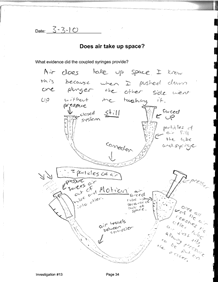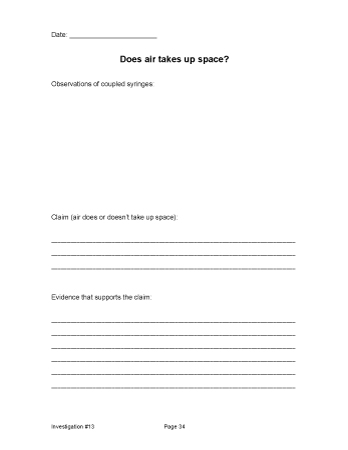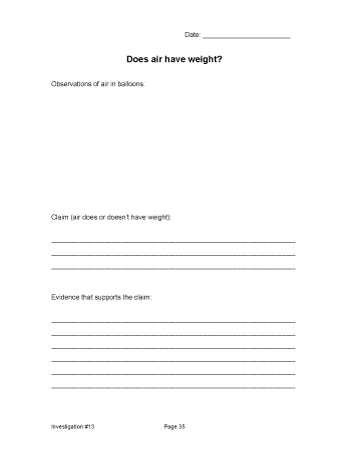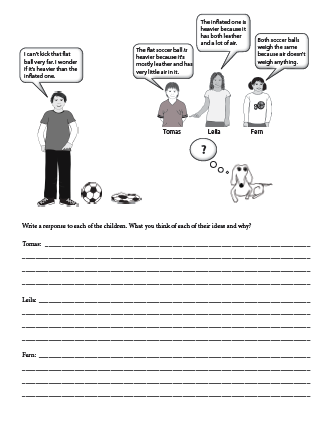Is air matter?
Plan Investigation 13
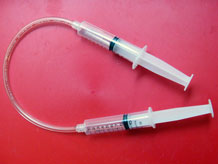
Air is our most familiar example of the state of matter we call gas. We live immersed in it and depend on it to stay alive. It's also invisible, not particularly tangible, and can be challenging to investigate. But, like solids and liquids, air is matter. It has weight (more than we might imagine), it takes up space, and it is composed of particles too small and too spread apart to see. Air, a mixture of gases, shares properties with water vapor, the gaseous form of water that is part of air. Understanding air helps us understand water vapor.
Formative Assessment
Can your students use data to reason that air is matter?
Available online at inquiryproject.terc.edu
Can your students use data to reason that air is matter?
Notebook entries contain evidence that students can use their observational data to make claims that air takes up space and has weight and is, therefore, matter.
Use these criteria to guide your interpretation of student work:
Annotated drawing of syringes
- Does the drawing show that air is continuous from one syringe, through the connecting tube, to the other syringe?
- Does the annotation indicate the student understands that that if you take away space for air in one syringe, the air has to go somewhere else and, therefore, creates this space by pushing on the plunger of the second syringe?
Annotated drawing of inflated balloon
- Does the student explain that that when the balloon with additional air pushes the balance pan down, this is evidence there an increase in weight that must have come from the added air?
Next steps might be a discussion of experiences from everyday life that provide similar evidence that air takes up space and has weight. For example, putting air in a tire pushes the tire out as the air fills the space and increases the weight.
Students' investigations of solids and liquids provided evidence that these materials have weight and take up space and are thus matter. Now students seek evidence that air (a gas) has weight and takes up space and is also mattter. This investigation is the first in a sequence of four in which students investigate the properties of air. In spite of our being able to move freely through air, students establish that air takes up space as they manipulate a system of coupled syringes. Through a convincing balloon demonstration, it is also established that air has weight.
By the end of this investigation students will have evidence that air takes up space, has weight, and, therefore, is matter. Students will be introduced to the idea that air is composed of particles too small and too spread apart to see.
Learning Goals
- Understand that air takes up space, has weight, and is matter composed of particles too small and too spread apart to see
| Sequence of experiences | ||
|---|---|---|
| 1. Ask the question | All Class | 10 Mins |
| 2. Explore air in a closed system | Pairs | 10 Mins |
| 3. Weigh balloons | All Class | 15 Mins |
| 4. Make meaning | All Class | 10 Mins |
Materials and Preparation
Preparation:
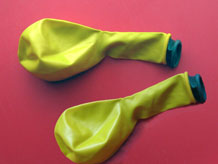
- Cut twelve 16in long pieces from the coil of clear plastic 1/4-inch tubing
- Assemble two sets of 16in double balloons. A double balloon is a set of two balloons, with one balloon inserted into the other balloon. Sliding the balloons over the eraser end of a pencil will help insert one balloon inside the other.
- Press a rubber stopper firmly onto the tip of the balloon pump (See photo).
- Practice using the balloon pump to inflate and tie off a double balloon. Only the inner balloon needs to be tied. Use one hand to squeeze the balloons against the rubber stopper. With the other hand, use rapid, continuous motion of the pump handle to inflate the double balloon to near-maximum size.
- Perfectly balance a double pan balance that has an uninflated double balloon in each pan.
Note: If you are unable to use latex balloons in your classroom, see the video Balloons on a Pan Balance online at inquiryproject.terc.edu, Grade 5 curriculum, Resource Quick Links or Investigation 13.
For the class: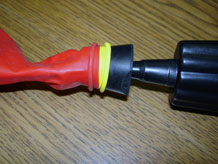
- Post the investigation question in a place where all students can see it.
- Dot Sheet 2 [pdf] (See Resource Quick Links)
- 1 double pan balance, perfectly balanced with an uninflated double balloon in each pan
- 1 balloon pump with rubber stopper inserted onto the tip
- 2 sets of 16in double balloons
- Balloons on a Pan Balance Video
- 2 16in lengths of clear plastic 1/4-inch tubing
- 4 12cc syringes
Concept Cartoon

The Air Has Weight Concept Cartoon is typically used as a formative assessment at the end of this investigation.
1. Ask the question
Review
Review some of the important ideas about ice, water, and particles.
- When a container of water freezes, or a container of ice melts, the weight remains the same.
- We use weight to measure and track the amount of matter.
- When water freezes, its volume increases.
- When ice melts, its volume decreases.
- When water freezes or ice melts, the properties change but the material does not.
- Ice and water are different states of the same material.
- Condensation forms from water vapor in the air.
- Condensation is the reverse of the process of evaporation.
- Scientists believe all matter is made of particles too small to see.
- In ice, particles are locked together, even when they vibrate, and hold their shape.
- In water, particles slide past and collide with one another, and take the shape of its container.
Ask students if they would like to make any additions or changes.
Launch the new strand
Explain that students are about to spend four science classes investigating air. When particles are clumped together, we can see the matter and use our classroom tools to measure the weight and volume. When the tiny particles are spread apart, we cannot see them. Water vapor is an example of a material whose tiny particles are spread apart so we can't see them. Air is another example. Air is actually a mixture and water vapor is part of air.
Today's investigation question is:
Is air matter?
Students have measured the weight and volume of both solid and liquid materials, and have established they are matter. Today students use some new tools as they look for evidence to determine whether or not air is matter.
2. Explore air in a closed system
Before you distribute the tubing and syringes, remind students that if air is matter, it has to take up space. A question is:
What positions do students take? Be sure to hear from students with positions on each side of the question. Ask students to make a claim and to provide the evidence or reasoning on which their claim is based.
Give each pair of students two syringes and a 16-inch length of clear plastic tubing, to set up the following system:
- Set the plunger of each syringe at the middle of its barrel (the 6 cc line).
- Push one end of the clear plastic tubing onto the tip of each syringe.
Describe this set-up as a system.
- The 2 syringes, tube, and air.
- Like the 2-bottle system, the connected syringes form a closed system. Nothing can get in or out once the system has been set up.
- The outside of the tubing and syringes.
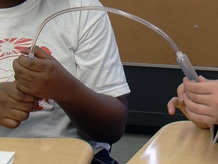
Have students explore the system. It takes no more than a minute or two for students to explore how the system works. The point is to let them experience a situation in which air clearly takes up space.
- What happens when you push one plunger very slowly while not touching the other plunger?
- What happens when you push one plunger very quickly while not touching the other plunger?
- Do you find evidence that air takes up space?
Collect the syringes while students write a response to the [Does air takes up space?] page in their Science Notebooks.
3. Weigh balloons
The Weight of Air
If you scoop a cup of water out of a large pot you can feel its weight. If you pour that water back into the pot, you would not expect that weight to cause the water to sink to the bottom of the pot and stay there, as if it were a rock. The water from the cup will mix in with and drift through the rest of the water as if it were weightless, because it has the same density as the water in the pot.
For the same reason, any specific quantity of air in the atmosphere appears to be weightless. However, air does have weight. Air pressure, which we hear about in weather reports, results from air's weight. Since we live with air pressure all around us, and even inside of us (e.g., lungs) we do not sense it. Even scales do not sense the weight of air, because they are completely surrounded by air pressure.
One way to demonstrate that a sample of air has weight is to make it denser than the surrounding air. It that case, the sample will sink in the atmosphere. Cold air is denser than warm air; more particles are packed into each cubic centimeter. Open the freezer door and you'll feel the cold air spilling down towards the floor. Compressed air is denser than uncompressed air, with more particles packed into each cubic centimeter.
Why a double balloon?
A balloon resists being stretched, so as it is inflated it compresses air particles closer together, making that air more dense than the uncompressed air in the room. A double balloon offers even more resistance to being inflated, and compresses the air particles even closer together, making the enclosed air dense enough for a balloon-sized quantity to tip the pan balance.
Students may not need this much information. The demonstration speaks for itself.
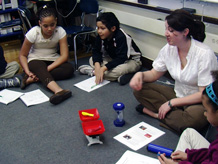
Remind students that if air is matter, it must have weight. A question is:
- No, you can't feel air and it doesn't register on a scale.
- Yes, because my soccer ball feels heavier after I pump it up with air.
What positions do students take? Be sure to hear from students with positions on each side of the question. Ask students to make a claim and to provide the evidence or reasoning on which their claim is based.

Show students the uninflated double balloons placed on each side of the double pan balance. Point out that the two sides balance and so there are equal weights on both sides. Next, ask students to imagine that the balloons on one side of the balance are inflated.
- What will we observe if air doesn't weigh anything?
- What will we observe if air does have weight?
Use the balloon pump (with the rubber stopper) to inflate one set of doubled balloons to its full size. Using a balloon pump to inflate a balloon avoids adding moisture from your lungs into the balloon, which in turn helps to establish the fact that "dry" air has weight.
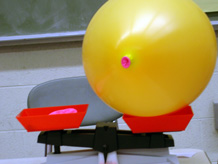
Tie off the opening of the inner balloon and return the inflated double balloon to the double pan balance. The pan with the inflated double balloon will move down.
Do we have evidence that air has weight?
Students record their responses on the [Does air have weight?] page in their Science Notebooks.
4. Make meaning
Note: Students may claim that air has weight and takes up space only when it is in a container. Does it make sense that weight and volume disappear once the closed system is open? Weight and volume of air are easier to perceive and measure when it is in a closed system and that is why we used the balloons in this investigation.
Purpose of discussion
The purpose of this discussion is to help students make sense of the results of today's experiences, which provide evidence that air has weight and takes up space. Students may feel that today's results are in conflict with other experiences they have had with air. Focus the discussion on the investigation question: Is air matter?
Engage students in the focus question?
Is air matter or not?
- Does air take up space? What is your evidence?
- Does air have weight? What is your evidence?
Claim or position: Air takes up space:
- When I take a really big breath of air, my chest expands.
- An inflated balloon takes up more space than an uninflated balloon.
Claim or position: Air doesn't take up space:
- I can walk right through air. (We can also walk through water, but we agree that water takes up space.)
- When a classroom is "filled" with air, how can there be room for students to come into it? (Unlike the syringes, the classroom is an open system; when students come in, they push some of the air out.)
Claim or position: Air has weight:
- When we added air to one set of balloons the balance went down on the side with the inflated balloon.
Claim or position: Air doesn't have weight:
- Scales don't register the weight of air.
- We can't feel weight even if there's a lot of it on top of us.
Summarize the discussion and recap the investigation
Summarize the arguments for each position. See if there is consensus for the argument that air takes up space and has weight, and therefore, is matter.
Thinking of air as matter, which puts it in the same category as the sand, gravel, and water in the mini-lakes, can require an adjustment in our thinking.
Remind students of the dissolved salt. It's easy to think of salt as matter, but even after the salt particles became too small and too spread apart to see, the salt maintained its weight and it still took up space: it maintained its classification as matter. This may be the strongest connection students can make between air and another substance they accept as matter.
Reiterate the concept that air has weight and takes up space, and thus is matter. The reason we can't see air is because the particles are tiny on a scale that's hard to imagine and are spread far apart. On a windy day, we have an easier time sensing the presence of air.
Air Has Weight Concept Cartoon
Learn about Concept Cartoons in the Concept Cartoons section available from the sidebar.by clicking the Assessment tab at the top of the Grade 5 curriculum Home Page.
This cartoon is designed to probe students' ideas about weight as a property of air. Three cartoon characters offer explanations for why it's harder to kick a deflated soccer ball than a ball filled with air. Ask students to follow along as you read the cartoon prompts and directions aloud. Remind students to respond to the pros and cons of each idea. Students' responses will give you insight into their understanding of the evidence that air has weight and is matter. This assessent will help you decide whether the class as a whole or individuals are ready to move on or if they would benefit from a review or additional experience with classroom activities.


